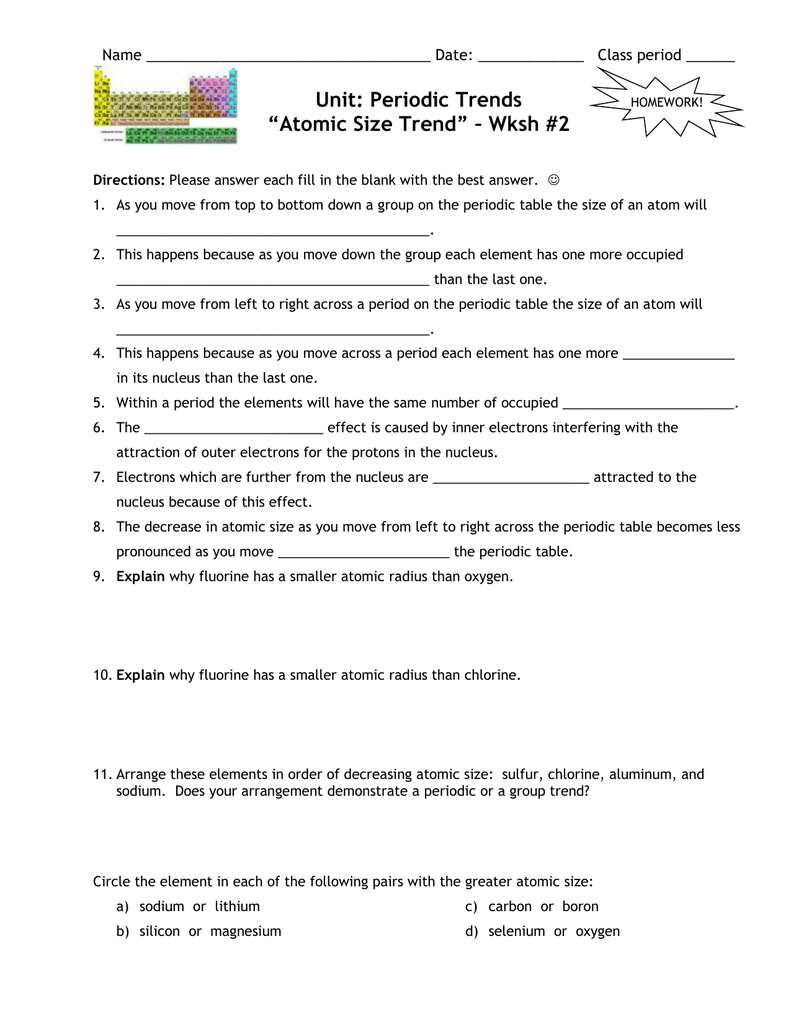Remember those intimidating chemistry lessons in high school, where we were forced to memorize the periodic table? I, like many others, found it overwhelming. But once I delved deeper, I realized it wasn’t just a jumble of symbols; it was a map of the fundamental building blocks of our universe. The periodic table, with its organized arrangement of elements, is a tool for understanding the behavior of atoms and compounds. And the “periodic trends” hidden within it describe the patterns of properties that repeat across this map. These trends, like the gradual increase in atomic size or electronegativity, are crucial for comprehending the reactivity and characteristics of elements.
Image: byveera.blogspot.com
This article serves as a guide for exploring the fascinating world of periodic trends. It’s specifically designed to aid students in their journey through this essential topic, providing a detailed understanding of these patterns and their implications. Whether you’re struggling to understand ionization energy or want to master the nuances of electronegativity, this exploration will equip you with the knowledge to confidently navigate the periodic table.
Understanding Periodic Trends: A Journey Through the Periodic Table
Imagine a vast landscape with mountains representing elements grouped by their shared properties. These “mountains” rise and fall, creating patterns, and these patterns are the periodic trends we’re learning about. The periodic table is not a random arrangement; it’s a carefully structured map based on the increasing atomic number of elements, which directly corresponds to the number of protons in their nucleus. As you move across a period (a horizontal row) or down a group (a vertical column), certain properties of the elements change in a predictable fashion, making them “trends.”
Key Periodic Trends and Their Significance:
Let’s delve into the key periodic trends, exploring how their variations impact the behavior of elements:
1. Atomic Radius: The Size of Atoms
The atomic radius defines the distance from the nucleus to the outermost electrons. As we move down a group, the atomic radius increases. This is because additional electron shells are added, creating a greater distance between the nucleus and the valence electrons. Conversely, moving across a period, the atomic radius decreases. This happens because the nuclear charge increases, pulling the electrons closer to the nucleus.

Image: www.onlineworksheet.my.id
2. Ionization Energy: The Energy to Remove an Electron
Ionization energy refers to the energy needed to remove an electron from a neutral atom in its gaseous state. Across a period, ionization energy generally increases due to the stronger attraction between the nucleus and electrons, making it harder to remove an electron. Down a group, ionization energy decreases because the outer electrons are farther away from the nucleus and are less tightly bound.
3. Electron Affinity: The Tendency to Gain Electrons
Electron affinity measures the change in energy when an electron is added to a neutral atom. Generally, elements on the right side of the periodic table have a greater tendency to gain electrons, resulting in a more negative electron affinity. This is due to their near-full valence shells, which provide a strong attraction for an incoming electron. Moving down a group, electron affinity tends to decrease due to the increased distance between the nucleus and the incoming electron.
4. Electronegativity: The Pull on Electrons in a Bond
Electronegativity describes the ability of an atom to attract electrons in a chemical bond. Across a period, electronegativity increases due to the stronger attraction between the nucleus and the bonding electrons. Moving down a group, electronegativity decreases because the outermost electrons are farther from the nucleus and less influenced by its pull.
Navigating the Periodic Trends: Tips for Success
Mastering periodic trends can be daunting, especially for beginners. But with the right approach, you’ll be able to navigate this fascinating landscape confidently. Here are some proven tips and expert advice to help you succeed:
1. Visualize and Connect the Dots:
Create visual aids, such as diagrams or charts, to represent the periodic trends. Use colors, arrows, and annotations to highlight the direction and magnitude of changes, and utilize online resources like interactive periodic tables to reinforce your understanding. Make connections between the trends; for example, visualize how the increase in ionization energy across a period corresponds to the decrease in atomic radius.
2. Practice, Practice, Practice:
The more you practice, the more you’ll solidify your understanding. Work through practice problems, quizzes, and answer keys to build your confidence. Engage with online tutorials and interactive exercises designed to reinforce these concepts.
3. Connect Theory to Real-World Applications:
Understanding the practical implications of periodic trends makes learning more engaging and meaningful. Look for real-world examples of how these trends influence the properties of materials we use daily. For instance, the high electronegativity of oxygen explains why water is a good solvent.
FAQs: Common Questions about Periodic Trends
Q1: What are the exceptions to the periodic trends?
While periodic trends are generally consistent, exceptions do exist. For example, in the case of ionization energy, some elements like nitrogen and oxygen have higher ionization energies than expected due to their electron configurations. Recognizing these exceptions requires a deeper understanding of electron configurations and their influence on atomic properties.
Q2: Why are periodic trends important in chemistry?
Periodic trends are essential in chemistry because they provide insights into the behavior and reactivity of elements. They help us predict the type of bonds elements might form, the strength of those bonds, and the chemical reactions they might participate in.
Student Exploration Periodic Trends Answer Key
Conclusion
Periodic trends are not just abstract concepts; they are the code that unlocks the secrets of the elements. They govern the properties of everything around us, from the air we breathe to the smartphones we use. By understanding these trends, you gain a deeper appreciation for the beauty and interconnectedness of chemistry. So, are you ready to dive deeper into the fascinating world of periodic trends?





